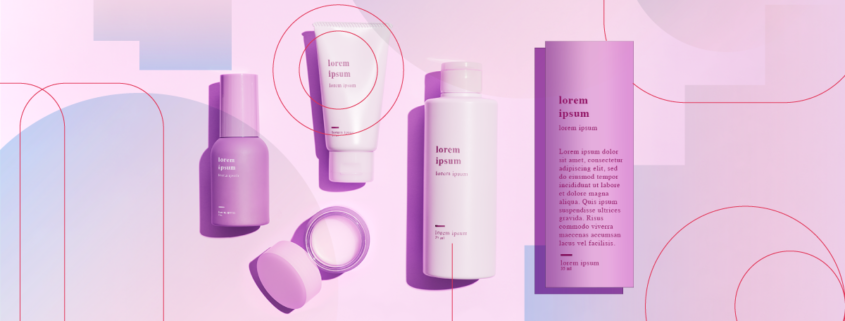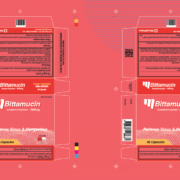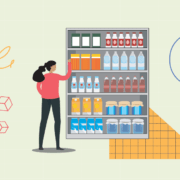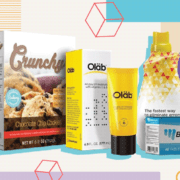Overcome Your Content Challenges in Cosmetic Labeling to Meet FDA Requirements
Date: December, 2022 | Category: Proofreading | Author: Hana Trokic
When most of us go out searching for our next “new favorite product,” we rely heavily on the claims written on the packaging. “All natural ingredients,” “results after only one use,” and “98% effective” are only some claims we see scattered across cosmetic aisles globally.
But just how effective are these labels? For perspective, ask yourself, would you buy a cosmetic product that didn’t have a label? What about a product that had errors and typos on its labeling? It’s safe to say that most of us would skip that product and move on to one with more enticing branding and trustworthy labeling and packaging.
In other words, packaging and labels are consumers’ first impressions of your product, so you want to get it right. As a form of advertising, cosmetic labels often include a long list of promises as manufacturers try to sell you on their claims. Yet, not only do they have to convince you of their guarantees of beauty and benefits, but they also need to sell you on its efficacy.
Moreover, cosmetic manufacturers operate in a highly regulated industry, further complicating the labeling process. Not only do they have to consider branding and marketing guidelines, but they also have to focus on FDA cosmetic labeling requirements, as there are strict rules and regulations behind every cosmetic label.
The Challenges of Cosmetic Labeling

All cosmetics marketed globally must comply with provisions set by the governing body of that specific country or region. In the United States, the FDA is responsible for regulating cosmetic labeling with the main goal of ensuring consumer safety and avoiding fraudulent and deceptive statements.
What are Cosmetics?
The FDA defines cosmetics as “articles intended to be applied to the human body for cleansing, beautifying, promoting attractiveness, or altering the appearance without affecting the body’s structure or functions.“
Some products that fall under this category include creams, lotions, perfumes, make-up, shampoos, toothpaste, and deodorants.
While it may seem clear what cosmetics are, manufacturers need to be careful when creating, labeling and marketing their cosmetic products to ensure they fit under the FDA’s definition and regulations. If not appropriately labeled, some claims may cause a product to fall under the category of a drug, in which case it has to undergo a set of regulations that differ significantly from cosmetics.
Though sometimes lines can be blurred, manufacturers must understand the difference between cosmetics and drugs and label their products properly to avoid potential complications, fines, and recalls.
Cosmetic Labeling
Cosmetic products distributed in the United States must comply with all label regulations established by the FDA. Labels are otherwise considered all written, printed, or graphic matter on or accompanying a product.
The FDA requires that all label statements appear on the inside and outside of the packaging and wrapping.
It is also important to note that false and misleading claims and wrongly labeled products that do not follow FDA cosmetic labeling requirements and regulations may be subject to regulatory action.
How to Correctly Label Cosmetics
To ensure the proper placement of cosmetics on the market and that consumers use them appropriately, manufacturers need to take note of adequate labeling requirements and adhere to them as strictly as possible.
A cosmetic label must contain the following:
- Product identity
- Net contents
- Declaration of Ingredients
- Label warnings
Product Identity
Product identity is the most crucial aspect of FDA cosmetics labeling requirements as it tells consumers what your product is and its intended use. Many cosmetic products and packaging look the same, i.e., lotions, shampoos, creams, etc.
The label and statement of identity are what help consumers tell them apart. Because of this, product identity has to be displayed on the front of the package, so the general public is immediately aware of its intended use.
Net Contents
Net contents tell consumers the quantity of your product, i.e., how much product is in the package.
Products that are solids display their net content in terms of weight, while liquid products display their contents in terms of volume. The accuracy of the net contents is also highly regulated by the FDA as it ensures that it accurately reveals the quantity of cosmetics in the container in terms of weight, volume, measure, numerical count, or combinations of count and weight, volume, or measure.
Declaration of Ingredients
All cosmetics under the FDA are required to bear an ingredient declaration.
The declaration of ingredients must be clearly visible so that it can be found and read at the time of purchase. The placement of the ingredients is not strictly standardized like the product name or net contents. It can be displayed on any information panel on the package.
The ingredients must also be listed in order of predominance. In other words, the ingredient with the highest percentage is listed first, while other ingredients are listed according to their percentage in descending order. Ingredients at 1% or less can be listed in no particular order at the end of the ingredient declaration.
Label Warnings
Cosmetics that may cause adverse reactions or be hazardous to consumers if improperly used must be addressed through FDA cosmetic labeling requirements. Appropriate warnings and directions of use need to be clearly labeled and prominently displayed.
Some cosmetics that fall into this category include:
- Aerosol products
- Deodorant sprays
- Children’s bubble bath
Overcoming the Cosmetic Labeling Challenges

Just as it’s crucial to follow FDA regulations for labels, it’s equally as important that those labels are entirely error-free. Typos and artwork errors can make cosmetic products seem untrustworthy and unreliable. After all, why would consumers trust the contents of a product that was so hastily packaged and labeled?
Once you have ensured your labels meet all FDA cosmetic labeling requirements, the next step is to ensure that your content and artwork are error-free.
Text comparison software is a tool that allows cosmetic manufacturers to run an automated side-by-side comparison of two files to identify discrepancies and errors with complete ease.
Eliminating the need for laborious and error-prone manual proofreading checks, this advancement in automated quality control simplifies, optimizes, and upgrades workflows to ensure that your cosmetic labels are always top quality and free from mistakes.
Through the simple addition of this software, manufacturers can proofread and run checks for every aspect of their labels and packaging. With accuracy and precision, the software finds errors and discrepancies in text, colour, graphics, barcodes, and print, to name a few.
To ensure that you keep your product’s quality, reliability, and status on the market, implement processes that keep your labels and packaging safe from unwanted errors.
Automated quality control streamlines revision and proofreading processes and brings endless benefits for businesses and manufacturers – especially those dealing with sensitive copy, documentation, and content, such as pharmaceuticals and cosmetic manufacturers.
Cosmetic Labels that Meet all FDA Requirements
A miracle in a bottle – a claim most cosmetic manufacturers love to make. Yet without proper labeling and packaging, it’s hard for them to make such a statement and sell consumers their product.
To ensure market success and picture-perfect labels that stand out, you must get your cosmetic labels right. Implement a text comparison tool that helps you create flawless labels, speeds up the content creation process and revision times, and gets your product to market in record time.
The benefits a file comparison tool will bring cosmetic manufacturers are countless and, in most cases, are a crucial company resource. The only way manufacturers can be completely confident that their content and products are error-free is through fast, accurate, and trusted software.
Ready to step into the world of automated proofreading? Request a demo of our innovative text comparison software and see how this technology can revolutionize your everyday business practices. Transform your quality control processes with GlobalVision.
Also, to learn more about how technology can help manage regulatory compliance, check out GlobalVision’s guide Digital Transformation for Pharmaceutical Packaging Quality.
Related Articles:
- Solving The Content Efficiency Problem in the Pharma Industry
- Your Complete Guide to Meeting FDA Labeling Requirements
- How to Ace FDA Food Label Compliance Review: Ensure Your Labels are Always Approved
- Ensure Your Labels Meet all FDA Drug Labeling Requirements with Automated Quality Control
- How to Ease the Labeling Proofreading Process for Medical Devices
Ensure your content is always error-free in record time with GlobalVision. Try it now for free.
Keep up with the latest updates in automated proofreading software. Sign up for our newsletter.









